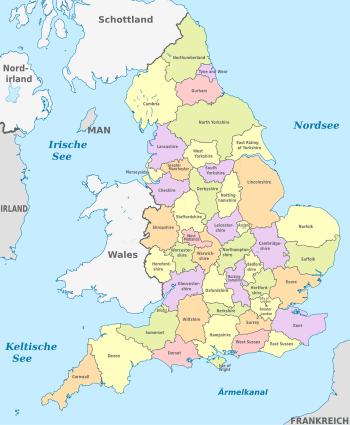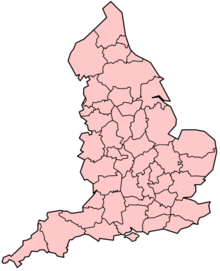Ceremonial counties of England
The ceremonial counties of England ( English ceremonial counties ) are territorial units in England , the one Lord Lieutenant , the personal representative of the British are assigned monarch. The assignment of the individual administrative districts to the 48 ceremonial counties was established by the government in the Lieutenancies Act 1997 . The ceremonial counties are frequently used as geographical names and therefore occasionally geographical counties (Engl. Geographic counties ) called. They are to be distinguished from the traditional counties of England .
Today's breakdown
- Northumberland
- Tyne and Wear
- Durham , including Darlington , Hartlepool and Stockton-on-Tees (as far as north of the tea )
- Cumbria
- Lancashire , including Blackburn with Darwen and Blackpool
- North Yorkshire , including York , Middlesbrough , Redcar and Cleveland, and Stockton-on-Tees (as far south of the tea )
- East Riding of Yorkshire , including Hull
- South Yorkshire
- West Yorkshire
- Greater Manchester
- Merseyside
- Cheshire , consisting of Cheshire East , Cheshire West and Chester , Halton and Warrington
- Derbyshire , including Derby
- Nottinghamshire
- Lincolnshire , including North Lincolnshire and North East Lincolnshire
- Rutland
- Leicestershire , including Leicester
- Staffordshire , including Stoke-on-Trent
- Shropshire , including Telford and Wrekin
- Herefordshire
- Worcestershire
- West Midlands
- Warwickshire
- Northamptonshire
- Cambridgeshire , including Peterborough
- Norfolk
- Suffolk
- Essex , including Southend-on-Sea and Thurrock
- Hertfordshire
- Bedfordshire , consisting of Bedford , Central Bedfordshire and Luton
- Buckinghamshire , including Milton Keynes
- Oxfordshire
- Gloucestershire , including South Gloucestershire
- Bristol
- Somerset , including Bath and North East Somerset and North Somerset
- Wiltshire , including Swindon
- Berkshire
- Greater London , excluding the City of London
- Kent , including Medway
- East Sussex , including Brighton and Hove
- West Sussex
- Surrey
- Hampshire , including Southampton and Portsmouth
- Isle of Wight
- Dorset , including Bournemouth, Christchurch and Poole
- Devon , including Plymouth and Torbay
- Cornwall , including the Isles of Scilly
- City of London
history

When in 1888 the current system of traditional counties was changed by counties Councils (Engl. County councils ) were set up and the system of administrative counties was built, the assignment of the areas was in England at the Lord Lieutenant, until then essentially conformed to the traditional counties (an exception being Bristol , for example , which had had a Lord Lieutenant for centuries), reformed. The new division combined the administrative counties and county boroughs into areas similar to those of the traditional counties. For example, the ceremonial county of Leicestershire was formed from the administrative counties of Leicestershire and the county borough of Leicester. Areas that were divided into several sub-areas (e.g. Suffolk in West Suffolk and East Suffolk ) were combined into a single ceremonial county. The ceremonial counties thus established after 1888 continued to be essentially the same as those that existed before 1888.
With the exception of minor border changes, these ceremonial counties existed until 1965. With the formation of Greater London that year , the office of Lord Lieutenant in Middlesex was abolished. In addition, the administrative county of Huntingdon and Peterborough was newly formed; however, this change was not reflected in the ceremonial counties.
In 1974 the county boroughs were dissolved as administrative units and the system of administrative counties was fundamentally reformed. At the same time, the design of the ceremonial counties was changed to match the administrative counties.
In 1990, some of the administrative counties that were newly formed in 1974 were dissolved again. These areas were either assigned to the existing ceremonial counties or grouped into new:
- Avon was essentially split between Gloucestershire and Somerset , with Bristol regaining its former ceremonial county status.
- Cleveland was split between North Yorkshire and County Durham .
- Hereford and Worcester was divided into the new ceremonial counties of Herefordshire and Worcestershire .
- Humberside was partially assigned to the new ceremonial county of East Riding of Yorkshire , with the remainder becoming Lincolnshire .
In 1997, Rutland's status as a ceremonial county was restored.
See also
- List of counties in the United Kingdom (including what their names mean)

